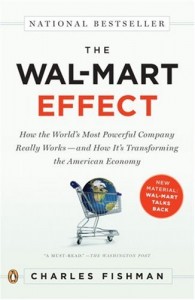 Well I’ve finally finished reading The Wal-Mart Effect. This book first came out in 2005, so I’m a bit behind and the information is a bit out of date. However, I do recommend reading this book, especially if you’re a Wal-Mart shopper.
Well I’ve finally finished reading The Wal-Mart Effect. This book first came out in 2005, so I’m a bit behind and the information is a bit out of date. However, I do recommend reading this book, especially if you’re a Wal-Mart shopper.
Now I don’t want to say never shop at Wal-Mart. I’ve shopped at Wal-Mart and there was a time in my life where if I needed a cheese grater, or towels, I could only really afford to shop at Wal-Mart (ok, maybe I’m still in this stage but I’ve made due without Wal-Mart for a couple years now). But I will say THINK about it when you shop at Wal-Mart.
Just to say something good about Wal-Mart…do you remember when deodorant came in boxes? It doesn’t any more. Wal-Mart made that happen, saving countless trees from being harvested to make deodorant boxes. Why did Wal-Mart do this? Each box cost 5 cents. They asked their suppliers to take out the box so Wal-Mart pays 5 cents less for each one bought, plus less weight to ship saving shipping costs. That’s a lot of saving when you think about how many people have deodorant that they buy 3 or 4 times a year. So they didn’t do it for the environment, but it worked out well anyway.
But what else happens when you want to squeeze 2 or 3 cents less per item from your suppliers? Well maybe the supplier has to use a cheaper material. Maybe they skip employee raises this year. Maybe, if you ask them over and over to find a way to take 2 or 3 cents off per item (which Wal-Mart does, often, and with a non-negotiable attitude), the supplier has to move it’s factory to China or Mexico.
The Wal-Mart Effect has a story of a company or two that went through each one of those steps. It has stories of real people, like the women from Bangladesh talking about factory conditions where if you made a mistake sewing a pair of pants the supervisors beat you with the pants. How does that make you feel about buying those pants for $20 at Wal-Mart? Not so great a deal anymore, is it?
Wal-Mart does do factory inspections overseas. They do a lot of them. But they also have a lot of factories that supply them and when you push and push to get cheaper products, things happen at those factories that Wal-Mart just can’t catch.
I don’t want to make this a super long post, so I can’t even really scratch the surface of the information in the book. There is also a very interesting afterward that talks of the initiatives Wal-Mart is taking to improve their image, such as cutting greenhouse emissions from all stores by 20% by 2012. Pretty impressive. But will they actually do it? I hope so. As much as we love to hate Wal-Mart, it is a global force that won’t be going away anytime soon and it affects many aspects of our everyday lives whether you shop there or not.
Hey… I just thought I’d mention that since that book (and probably a lot because of that book), Walmart has done an overhaul to it’s ‘green’ image, and sustainability. My dad, whose job title involves “Corporate Social Responsibility”, was telling me that Walmart has actually become a leader among large corporations with the initiatives that it has been undertaking. Their new stores have all these lower energy improvements… simple things like the lights inside the freezer cases being turned very dim until you walk in front of it, then they turn bright.
I’m not saying that Walmart is awesome and everyone should shop there every day, but I am saying that they are clearly making efforts to make many changes… which is more than can be said for many other chain stores.
I saw the book on yor blog’s bookshelf and it peeked my interest. I was amazed at the impact this company has.